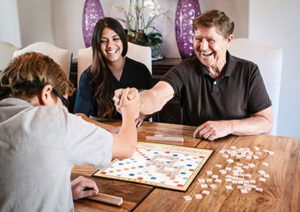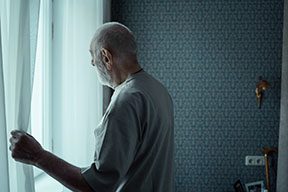Each year, over 795,000 people in the United States experience a stroke, according to the Centers for Disease Control. Of these, about 610,000 are first-time strokes, while roughly 185,000—nearly 1 in 4—occur in individuals who have already had a stroke. The CDC, the American Stroke Association, and other leading health organizations note a silver lining to this dark cloud of statistics—that up to 80 percent of strokes are preventable through lifestyle changes and managing medical conditions.
Promoting prevention is why American Stroke Month was created to raise awareness and share information about treatment and recovery. For families navigating life after a loved one has experienced a stroke, the journey can be filled with uncertainty and emotional challenges.
Most Common Cause of Stroke in the Elderly
The most common type of stroke in older adults is ischemic stroke, which accounts for nearly 87% of all strokes. This occurs when a blood clot or buildup of plaque blocks blood flow to the brain. The most common underlying cause of ischemic stroke in seniors is high blood pressure (hypertension). Over time, high blood pressure can damage the arteries, leading to narrowing, blockages, or clot formation—any of which can trigger a stroke.
Here are additional risk factors that contribute to stroke in the elderly:
High blood pressure (hypertension): The leading cause of stroke, often called the “silent killer” because it may not show symptoms.
Diabetes: Increases the risk of ischemic stroke due to damage to blood vessels over time.
Heart disease: Conditions like atrial fibrillation and previous heart attacks significantly raise stroke risk.
Smoking: Damages blood vessels and raises blood pressure, doubling the risk of stroke.
High cholesterol: Can lead to plaque buildup in arteries, restricting blood flow to the brain.
Obesity and sedentary lifestyle: These contribute to many other stroke risk factors including diabetes and heart disease.
Previous strokes or transient ischemic attacks (TIAs): A history of stroke greatly increases the chance of having another.
Family history and genetics: A family history of stroke or cardiovascular disease may increase risk.
Age and gender: Stroke risk increases with age, and women—especially those over 75—are more likely to die from a stroke.
Understanding these risks empowers families to take proactive steps toward prevention—and respond quickly if symptoms arise.
The Role of Non-Medical Home Care from Amada Senior Care in Stroke Recovery
Strokes are a leading cause of long-term care for seniors. While non-medical home care isn’t a replacement for physical therapy or medical treatment, it can be a lifeline for stroke survivors and their families. Here’s how:
1. Assistance with Daily Activities
After a stroke, even simple tasks like dressing, bathing, or preparing a meal can become daunting. Amada trained caregivers provide respectful, compassionate assistance that helps restore dignity and confidence.
2. Fall Prevention and Safety Monitoring
Stroke survivors are at a higher risk for falls. We assess the home environment and help reduce hazards by ensuring clear pathways, proper lighting, and mobility support.
3. Encouraging Medication Compliance
While we do not administer medication, caregivers can provide reminders and monitor routines to support adherence to prescribed regimens.
4. Companionship and Emotional Support
Emotional recovery is just as important as physical healing. Loneliness, depression, and frustration are common post-stroke challenges. Amada caregivers provide consistent companionship, helping seniors feel seen, heard, and valued.
5. Support for Family Caregivers
Stroke recovery affects the entire household. We offer respite care so that family members can take breaks, attend appointments, or simply recharge—knowing their loved one is in capable hands.
Tips for Families Supporting Stroke Recovery at Home
Be patient and encouraging. Progress may be slow, but every small step counts.
Stay organized. Keep a journal of medical appointments, medication schedules, and therapy exercises.
Create a calming routine. A structured daily plan can help reduce anxiety and confusion.
Celebrate milestones. Whether it’s taking a few steps unaided or completing a puzzle, acknowledge and celebrate progress.
Ask for help. You don’t have to do this alone—professional support can make all the difference.
Get the Help You Need to Support a Loved One Recovering from a Stroke
Stroke recovery is a marathon, not a sprint. At Amada Senior Care, we are honored to walk alongside seniors and their families during this critical time. Our non-medical support services aim to ease the burden on families while promoting safety, comfort, and independence at home.
As we observe American Stroke Month, let’s recommit to creating a safer, more supportive home environment where recovery can truly thrive. If your loved one is recovering from a stroke and you’re exploring home care options, we’re here to help. Contact us today for a free in-home consultation and learn how we can support your family.















